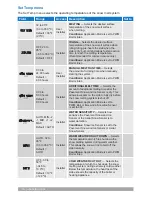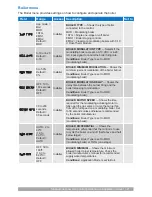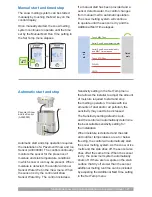
Single-zone snow melt control installation and operation manual | 9
Conduit connection
The slab sensor and slab sensor
enclosure (sold separately) are specifically
designed to mount onto a ⅜" (10mm) I.D.
temperature well that is supplied with an
end groove. To install the well, plumb a ‘T’
into the pipe and fix the well into the ‘T’.
Remove the ⅞" (22mm) back knockout to
place the enclosure over the temperature
well. Then insert the universal sensor
into the well and snap the retaining clip
supplied with the enclosure onto the well
end groove. If the well has a threaded end,
add a standard threaded conduit retaining
ring. The two wires from the sensor are
connected to the terminal block provided
in the enclosure. The other side of the
terminal block is used to connect wires
from the control.
Testing the sensor wiring
A good-quality test meter capable of
measuring up to 5,000 kΩ (1 kΩ = 1000
Ω) is required to measure the sensor
resistance. In addition to this, the actual
temperature must be measured with either
a good quality digital thermometer, or if
a thermometer is not available, a second
sensor can be placed alongside the one to
be tested and the readings compared.
First measure the temperature using
the thermometer and then measure the
resistance of the sensor at the control. The
wires from the sensor must not be connected
to the control while the test is performed.
Using the chart below, estimate the
temperature measured by the sensor. The
sensor and thermometer readings should
be close. If the test meter reads a very high
resistance, there may be a broken wire, a
poor wiring connection or a defective sensor.
If the resistance is very low, the wiring may
be shorted, there may be moisture in the
sensor or the sensor may be defective. To
test for a defective sensor, measure the
resistance directly at the sensor location.
Testing the control wiring
Testing the power
1. Remove the front cover from
the control.
2. Use an electrical test meter to
measure AC voltage between the
R and C terminals. The reading
should be 24 VAC +/– 10%.
3. Install the front cover.
Temp. Resistance Temp. Resistance Temp. Resistance Temp. Resistance
ºF ºC
Ω
ºF ºC
Ω
ºF ºC
Ω
ºF ºC
Ω
-50 -46
490,813
20 -7
46,218
90 32
7,334
160 71
1,689
-45 -43
405,710
25 -4
39,913
95 35
6,532
165 74
1,538
-40 -40
336,606
30 -1
34,558
100 38
5,828
170 77
1,403
-35 -37
280,279
35 2
29,996
105 41
5,210
175 79
1,281
-30 -34
234,196
40 4
26,099
110 43
4,665
180 82
1,172
-25 -32
196,358
45 7
22,763
115 46
4,184
185 85
1,073
-20 -29
165,180
50 10
19,900
120 49
3,760
190 88
983
-15 -26
139,403
55 13
17,436
125 52
3,383
195 91
903
-10 -23
118,018
60 16
15,311
130 54
3,050
200 93
829
-5
-21
100,221
65 18
13,474
135 57
2,754
205 96
763
0
-18
85,362
70 21
11,883
140 60
2,490
210 99
703
5
-15
72,918
75 24
10,501
145 63
2,255
215 102
648
10 -12
62,465
80 27
9,299
150 66
2,045
220 104
598
15
-9
53,658
85 29
8,250
155 68
1,857
225 107
553
Do not apply voltage to a
sensor at any time as damage
to the sensor may result.










































